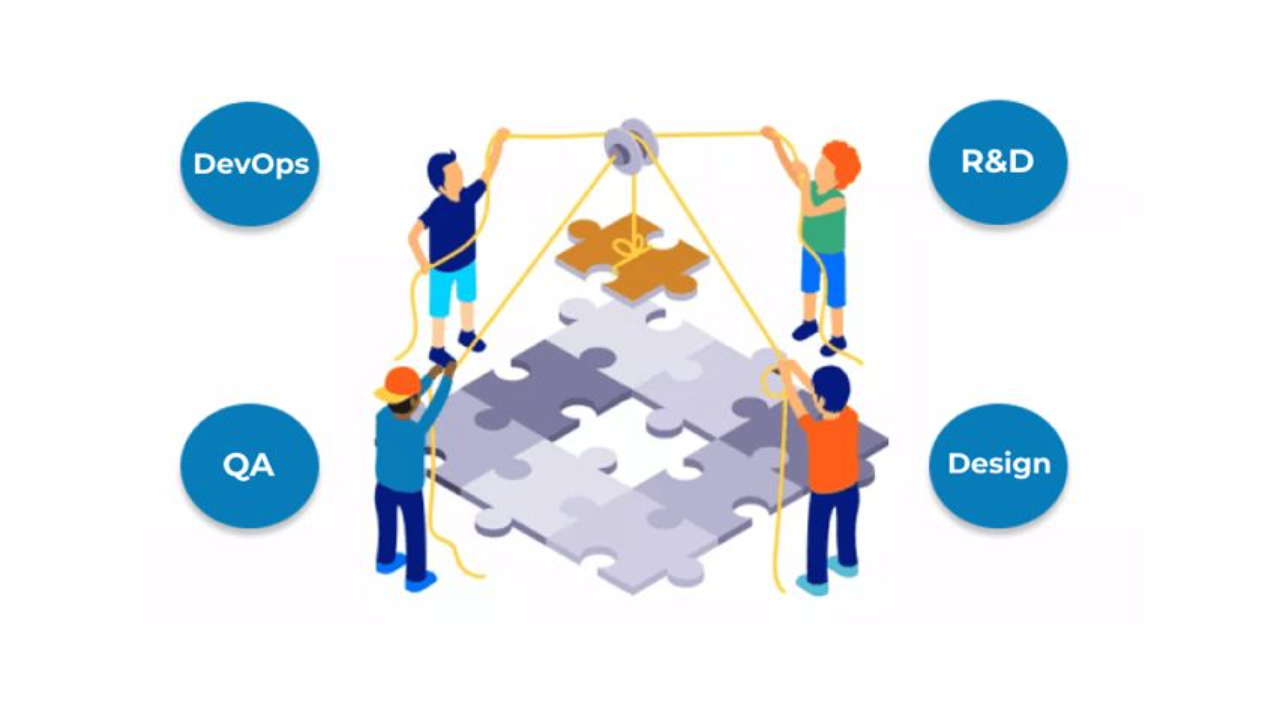Cross-Functional Teams in Agile: How to Build Effective Collaboration
May 07, 2025
In today’s fast-paced business environment, the need for effective collaboration is greater than ever. With projects becoming increasingly complex and interconnected, teams must work together seamlessly across different functions to achieve success. Agile methodologies, known for their focus on flexibility, collaboration, and iterative development, have become the foundation for many organizations striving to enhance teamwork and speed up product delivery. One of the most effective ways Agile teams foster collaboration is through the use of cross-functional teams.
A cross-functional team in Agile consists of individuals from diverse departments and expertise areas, coming together to work on a shared goal. The idea is to break down silos within the organization and promote better communication, cooperation, and alignment between different functions, such as marketing, development, design, and operations. However, while the concept of cross-functional teams sounds great in theory, it comes with its own set of challenges, particularly around fostering effective collaboration.
This blog post will explore how to build and maintain effective collaboration within cross-functional teams in Agile projects, highlighting the pain points teams face, and offering tools and strategies for ensuring better Agile collaboration and teamwork.
What Are Cross-Functional Teams in Agile?
Before diving into how to enhance collaboration, let’s first understand what cross-functional teams are and how they work within an Agile framework.
In the context of Agile, cross-functional teams are groups of individuals from various departments or skill sets who work together to complete a specific task or project. These teams are typically self-organizing, with each member contributing their unique expertise. In Agile, this could mean collaboration between developers, designers, product owners, testers, marketing professionals, and other departments.
The idea behind these teams is to create an environment where everyone works together on the same goals, from the start of a project to the delivery of the final product. This leads to faster problem-solving, improved communication, and ultimately, more successful project outcomes.
The Importance of Cross-Functional Collaboration in Agile
Cross-functional collaboration in Agile is essential for a variety of reasons:
- Increased Innovation: Bringing together people from diverse backgrounds and expertise areas often leads to more creative and innovative solutions to problems.
- Faster Decision-Making: With representatives from multiple functions working together, decisions can be made quickly without waiting for approvals from other departments, which leads to faster execution and delivery.
- Improved Quality: When teams collaborate closely throughout the entire development process, they can catch issues early, ensure alignment, and deliver a product that meets customer expectations.
- Better Alignment with Business Goals: Cross-functional teams allow all members to stay aligned with the overall business goals and customer needs, ensuring that everyone is working toward the same objectives.

Challenges in Cross-Functional Teams and Collaboration
Despite the numerous benefits of Agile collaboration, cross-functional teams face several common pain points that can hinder their effectiveness. Some of these challenges include:
Lack of Effective Teamwork
When people from different functions come together, it’s easy for team members to get stuck in their own departmental silos. This can result in misunderstandings, poor communication, and a lack of cooperation. Without the right tools, practices, and a clear vision, cross-functional collaboration can be ineffective and counterproductive.
Poor Cross-Department Communication
One of the main reasons cross-functional teams struggle is poor communication between departments. For instance, developers might not always understand the priorities of marketing, and designers might not understand the technical limitations of development. This can lead to misalignment, delayed deliverables, and frustration among team members.
Role Confusion and Responsibility Overlap
Cross-functional teams often include people with different job titles and responsibilities, which can lead to role confusion. For example, a marketing professional may feel the need to step into product management duties, or a developer may try to take over design tasks. If roles are not clearly defined, it can create tension within the team, leading to inefficiency and lower morale.
Resistance to Change and Traditional Silos
Teams that have been working in traditional, siloed environments for a long time may resist the transition to cross-functional Agile teams. Members may be accustomed to working in their department without having to collaborate extensively with others. Overcoming this resistance requires strong leadership and a shift in mindset.

How to Build Effective Cross-Functional Collaboration in Agile
Now that we’ve discussed the importance of cross-functional teams in Agile and some of the challenges teams face, let’s explore how to build and sustain effective collaboration within these teams. Here are some practical tools and strategies that can help:
Create a Shared Vision and Clear Goals
One of the first steps in fostering collaboration within cross-functional teams is ensuring that everyone is aligned with a shared vision. When team members understand the big picture and are clear about the project goals, they are more likely to work together effectively.
- How to implement: Start every project with a kick-off meeting where the Product Owner (PO) or project leader explains the goals, scope, and expected outcomes. Define success early on and ensure that all team members understand how their contributions impact the project.
Foster a Culture of Open Communication
Effective communication is the backbone of cross-functional collaboration. Agile teams should have open communication channels to share updates, ask questions, and discuss challenges in real time. Regular meetings like daily stand-ups and retrospectives are essential for maintaining good communication.
- How to implement: Use collaboration tools like Slack, Microsoft Teams, or Trello to ensure smooth communication across departments. Encourage team members to speak openly during meetings and use visual aids like Kanban boards to track progress.
Encourage Collaborative Decision-Making
Agile teams thrive when all members contribute their perspectives and expertise. Instead of making decisions in isolation, encourage collaborative decision-making, where everyone has a voice. This ensures that solutions reflect the insights and concerns of all functions.
- How to implement: Hold regular sprint planning sessions where cross-functional team members contribute to decision-making. Involve all relevant stakeholders, including marketing, design, and development, in discussions about priorities and scope.
Define Roles and Responsibilities Clearly
Clear role definition is critical to prevent role confusion and responsibility overlap. While cross-functional teams bring together individuals from various departments, it’s important to clearly define each person’s role and how they contribute to the project.
- How to implement: During the project initiation phase, clarify each team member’s role and responsibilities. Ensure that everyone knows their tasks and that there is no overlap in responsibilities. If roles change throughout the project, communicate these changes clearly.
Use Agile Tools for Collaboration
Agile tools can streamline communication and help teams stay organized. These tools allow for easy tracking of tasks, sharing of progress, and real-time collaboration. Common Agile tools like Jira, Asana, and Monday.com can improve team collaboration by providing a centralized location for task management.
- How to implement: Invest in project management tools that support Agile workflows. Use these tools for task tracking, backlog management, and team collaboration. Ensure that the entire team is trained on how to use these tools effectively.
Build Trust and Foster Mutual Respect
Trust is a critical element of any team’s success. When members of a cross-functional Agile team trust each other, they are more likely to collaborate effectively and be open to others’ ideas and feedback. Leaders should encourage mutual respect and create an environment where team members can freely express their opinions.
- How to implement: Promote team-building activities and encourage informal communication to strengthen relationships. Hold team retrospectives regularly to give team members a platform to voice their concerns and celebrate achievements.
Encourage Continuous Improvement
Agile collaboration thrives on continuous improvement. Teams should constantly reflect on how they are working together and find ways to improve their processes. This applies not just to product development, but also to the way the team collaborates.
- How to implement: Use retrospectives to review team collaboration and identify areas for improvement. Set aside time after each sprint to discuss what went well and what could be improved in terms of team collaboration and communication.
FAQ’s
What are cross-functional teams in Agile?
Cross-functional teams in Agile are teams composed of members from different departments or areas of expertise, such as development, design, marketing, and operations. These teams work together to achieve a shared goal, leveraging each member’s unique skill set to deliver a product or solution iteratively.
Why are cross-functional teams important in Agile projects?
Cross-functional teams are important in Agile because they encourage collaboration and bring together diverse perspectives. This leads to faster problem-solving, better decision-making, and a more holistic approach to meeting project goals. It ensures all aspects of product development are covered, reducing delays and improving overall product quality.
What are the main challenges in building cross-functional teams in Agile?
Some common challenges include lack of effective teamwork, poor communication across departments, role confusion, and resistance to change. These challenges can hinder collaboration and slow down project progress. Clear role definition, regular communication, and leadership support are key to overcoming these obstacles.
How can poor communication affect cross-functional teams in Agile?
Poor communication can lead to misunderstandings, misalignment on goals, and missed deadlines. In Agile, where quick decisions and close collaboration are essential, poor communication can delay progress, reduce productivity, and cause frustration among team members.
How can I improve communication in cross-functional Agile teams?
Improving communication can be achieved by encouraging regular check-ins like daily stand-ups, using collaboration tools like Slack or Trello, and ensuring transparency through visual management boards. Foster a culture where team members are encouraged to share updates, concerns, and feedback openly.
What role does the Product Owner play in cross-functional teams?
The Product Owner (PO) plays a key role in aligning the team around the project vision and ensuring that the backlog is well-prioritized. The PO acts as a bridge between stakeholders and the team, helping facilitate collaboration by clarifying requirements, making quick decisions, and providing direction on priorities.
How can I overcome role confusion in cross-functional teams?
Role confusion can be addressed by clearly defining each team member’s responsibilities from the beginning. Make sure everyone knows their specific tasks, how their work contributes to the team’s goals, and how they should collaborate with other functions. Regular retrospectives can help refine and adjust roles as needed.
What are the best tools for fostering cross-functional collaboration in Agile teams?
Some of the best tools for fostering collaboration include:
Slack for real-time communication.
Trello or Jira for task management and progress tracking.
Confluence for sharing documentation and collaborating on ideas.
Zoom or Teams for video conferencing and meetings. These tools help streamline communication, task management, and overall collaboration across departments.
How can leadership support cross-functional collaboration in Agile?
Leadership can support collaboration by setting a clear vision, ensuring open communication channels, and providing the necessary resources and training for cross-functional teams to succeed. They should also encourage a culture of trust and mutual respect, where every team member’s contributions are valued and recognized.
How do cross-functional teams contribute to faster product development in Agile?
Cross-functional teams in Agile contribute to faster product development by eliminating bottlenecks that occur when teams work in silos. With all necessary expertise available in one team, decisions can be made faster, issues are addressed more quickly, and iterations can be completed more efficiently, leading to faster time to market and better product quality.
Conclusion
Building effective collaboration in cross-functional teams is essential for the success of any Agile project. By fostering a culture of open communication, defining roles clearly, and using the right tools, Agile teams can work together more efficiently, deliver products faster, and create a better experience for customers. The strategies outlined above provide a solid foundation for enhancing teamwork within Agile teams and addressing common pain points such as poor communication and role confusion.
By following these strategies, organizations can maximize the potential of their cross-functional teams and drive better outcomes, resulting in faster product development and a more collaborative work environment. The key to success lies in strong leadership, a shared vision, and a commitment to continuous improvement, all of which are central to the Agile approach.
Stay connected with news and updates!
Join our mailing list to receive the latest news and updates from our team.
Don't worry, your information will not be shared.
We hate SPAM. We will never sell your information, for any reason.


